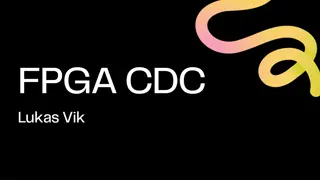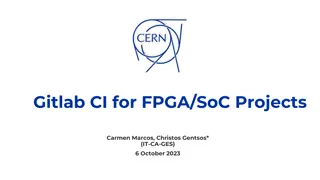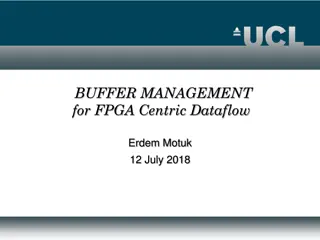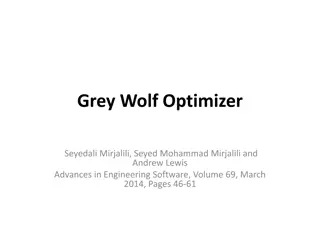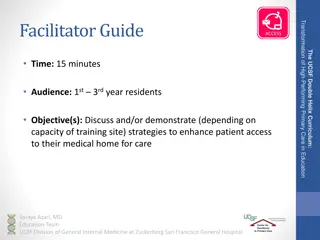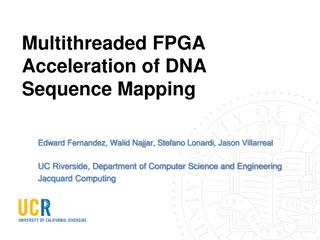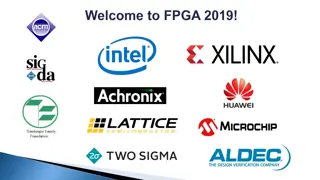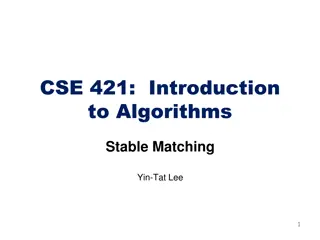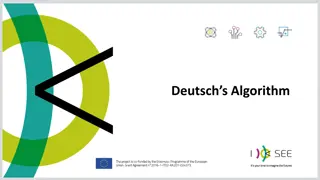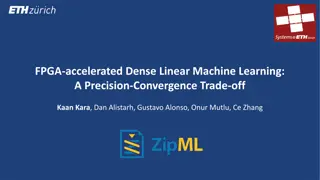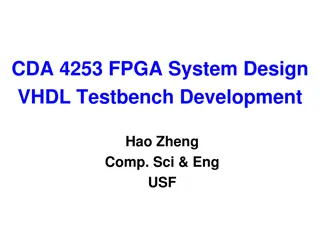FPGA Helix Tracking Algorithm for PANDA
This study introduces an FPGA-based helix tracking algorithm for the PANDA experiment's Straw Tube Tracker (STT). The algorithm involves road finding, momentum calculation, C++ performance study, VHDL implementation, and track quality assessment through circle parameter determination. Various images depict the STT structure, algorithm details, and performance evaluations based on realistic events with time-based information to improve momentum resolution.
Download Presentation

Please find below an Image/Link to download the presentation.
The content on the website is provided AS IS for your information and personal use only. It may not be sold, licensed, or shared on other websites without obtaining consent from the author.If you encounter any issues during the download, it is possible that the publisher has removed the file from their server.
You are allowed to download the files provided on this website for personal or commercial use, subject to the condition that they are used lawfully. All files are the property of their respective owners.
The content on the website is provided AS IS for your information and personal use only. It may not be sold, licensed, or shared on other websites without obtaining consent from the author.
E N D
Presentation Transcript
FPGA Helix Tracking Algorithm for PANDA Yutie Liang, Martin Galuska, Thomas Ge ler, Wolfgang K hn, Jens S ren Lange, David M nchow, Bj rn Spruck, Milan Wagner II. Physikalisches Institut, JUSTUS-LIEBIG-UNIVERSIT T GIESSEN 09.09.2014
Outline 1. Introduction to the PANDA Straw Tube Tracker (STT) 2. Road finding and momentum calculation 3. Performance study with C++ 4. Implementation with VHDL 5. Summary and outlook 2
Straw Tube Tracker (STT) 4636 Straw tubes 23-27 planar layers 15-19 axial layers (green) in beam direction 4 stereo double-layers for 3D reconstruction, with 2.89 skew angle (blue/red) From STT : Wire position + drift time 3
Tracking Algorithm -- Road Finding Layer_ID Hit Hit Hit Hit Hit Hit Hit Hit Hit Hit Hit Tube_ID Hit: Seg_ID(3 bits) + LayerID(4 bits) + Tube_ID (6 bits) + Arrival time Boundary between two segments. 1: Start from inner layer Number of neighbor: 2: Attach neighbour hit to tracklet layer by layer 4 in axial layer; 6 in stereo layer 4
Tracking Algorithm -- helix parameters calculation Known : xi, yi, di Question: To determine a circle, y x2+ y2+ ax + by + c = 0 xc, yc, R Method: Minimize the equation E2= (xi2+ yi2+ a xi+ b yi+ c)2 (1/di)2 x S S S a S S Sx= xi Sxx= xixi Sxxx= xixixi xx xy x xxx xyy 1) Circle para. = S S S b S S xy yy y xxy S yyy S S N c S x y xx yy 2 2 2 + + + ( / ) 2 x ax y by r i 2 = i i i i / 1 n 2) Track quality. 2 d i 5
To Improve the Momentum Resolution -- using a 2nditeration y Pt(input) 1stiteration 2nditeration 0.2GeV/c : 0.195 0.0068 0.195 0.0068 0.5GeV/c : 0.5 0.0212 0.5 0.0164 1.0GeV/c : 0.99 0.0595 1.0 0.0317 2.0GeV/c : 1.85 0.213 2.0 0.073 xc, yc, R x 1stiteration 2nditeration Pt(GeV/c) 6 Pt(GeV/c)
Performance Study -- realistic events, time-based T0information: current event(Red) or other events(Green) Black dashed line: track by MC truth Red line: recon. track Blue: recon. using outer layers drift circles belong to current event (Red) or other events (Green) Event #4 Event #4 7
Assign Track to Correct Event T0information: current event(Red) or other events(Green) Black dashed line: track by MC truth Red line: recon. track Blue: recon. using outer layers drift circles belong to current event (Red) or other events (Green) Event #1 Event #1 8
Pz reconstruction 1: The radius, the position of the helix center in the XY plane are determined. 2: = kZ + 0 One cylinder the helix lies in. Based on Pt determined before y Crossing points (ellipse) One straw tube x z Track need to be tangent to the crossing ellipse. Gianluigi Boca and Panda Collaboration, Panda STT TDR, 2012 9
Pz reconstruction Method: Minimize E2= ( i+ kzi+ 0)2 (1/di)2 Known : zi, i, di Question: To determine a line, S k S S 1 z zz z = S S + kz + 0= 0 0 z 10
Pz reconstruction Pt = 0.5 GeV/c Pt = 1.0 GeV/c Pt = 2.0 GeV/c Pz(input) 0.25 GeV/c : 3.7 % 0.50 GeV/c : 4.0 % 1.00 GeV/c : 4.3 % Pz(input) 0.5 GeV/c : 3.1 % 1.0 GeV/c : 3.8 % 2.0 GeV/c : 4.2 % Pz(input) 1.0 GeV/c : 3.7 % 2.0 GeV/c : 4.8 % 4.0 GeV/c : 5.2 % 11
VHDL Implementation VHDL: Very-high-speed integrated circuits Hardware Description Language. Square root : Look-up table (1-2000) 1-4 4-16 16-64 64-256 Division: Look-up table a/b = (a*2^n) / (b*2^n) b*2^n in (0.5-1) 12
Performance at FPGA Pz calculation not finished yet. 1: Device Utilization Summary: Previous design 34% 1% 42% 1% 58% 96% 2: Time per event: For one event with 100 hits (6 tracks): (1) 100 clock cycles (cc) (2) 50 cc * 6 (3) ~200cc * 6 /(3 or 4) Previous: (1) 100 clock cycles (cc) (2) 50 cc * 6 (3) ~50cc * 6 13
Tracking at FPGA -- at low event rate Data flow: Hit information at PC FPGA, extract helix para. PC PC is used to draw hits and helix in the plot. The helix parameters come from FPGA.14
Tracking at FPGA -- at low event rate Data flow: Hit information at PC FPGA, extract helix para. PC PC is used to draw hits and helix in the plot. The helix parameters come from FPGA.15
Tracking at FPGA -- at low event rate Data flow: Hit information at PC FPGA, extract helix para. PC PC is used to draw hits and helix in the plot. The helix parameters come from FPGA.16
Tracking at FPGA -- 20 MHz Data flow: Hit information at PC FPGA, extract helix para. PC PC is used to draw hits and helix in the plot. The helix parameters come from FPGA.17
Tracking at FPGA -- 20 MHz Data flow: Hit information at PC FPGA, extract helix para. PC PC is used to draw hits and helix in the plot. The helix parameters come from FPGA.18
Tracking at FPGA -- 20 MHz Data flow: Hit information at PC FPGA, extract helix para. PC PC is used to draw hits and helix in the plot. The helix parameters come from FPGA.19
Summary and Outlook C++ VHDL Pt 1stiteration Pt2nditeration 2calculation Pz1stiteration On going Pz2nditeration On going 5 s/event , 100 FPGA @ 20MHz interaction rate Next to do: Optimize the VHDL code. Include MVD points Test with PTDAQ. 20
Thank you 21
VHDL implementation T0 T0 .. .. .. 9 Hit Hit Hit Hit Hit Hit Hit Hit Hit Hit Hit Hit 8 7 5 6 ToT 3 4 2 1 T0 Tracking module Input Interface Form tracklet 2D Mapping Calc Mom Index Ring Buffer 24
Hardware Description Language VHDL, Verilog, SystemC VHDL: Very-high-speed integrated circuits Hardware Description Language. It s a dataflow language, unlike procedural computing languages such as C++ which runs sequentially, one instruction at a time. Signal A3_B1 ; Signal A4_B2 ; A1 A3 B1 B3 A3 <= A3_B1; B1 <= A3_B1; A B A4 B2 A2 B4 A4 <= A4_B2; B2 <= A4_B2; 26
Setup and Test PC as data source and receiver. Ethernet. Optical link (UDP by Grzegorz Korcyl ) (not integrated yet) Ethernet via Optical Link FPGA FIFO Tracking algorithm FIFO 27
Assign a track to the correct event T0information: current event(Red) or other events(Green) Black dashed line: track by MC truth Red line: recon. track Blue: recon. using outer layers drift circles belong to current event (Red) or other events (Green) Event #2 Event #2 28
Performance study single track y(cm) y(cm) 0.2GeV 0.5GeV x(cm) x(cm) 1GeV 2GeV y(cm) y(cm) x(cm) x(cm) 29
Pz reconstruction Pt = 0.5 GeV/c Pt = 1.0 GeV/c Pt = 2.0 GeV/c Pz(input) 0.25 GeV/c : 3.7 % 0.50 GeV/c : 4.0 % 1.00 GeV/c : 4.3 % Pz(input) 0.5 GeV/c : 3.1 % 1.0 GeV/c : 3.8 % 2.0 GeV/c : 4.2 % Pz(input) 1.0 GeV/c : 3.7 % 2.0 GeV/c : 4.8 % 4.0 GeV/c : 5.2 %

